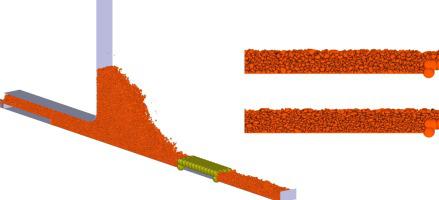Additive Manufacturing ( IF 11.0 ) Pub Date : 2020-06-30 , DOI: 10.1016/j.addma.2020.101421 Daniel Schiochet Nasato , Thorsten Pöschel

|
Understanding the mechanical behavior of powders used in additive manufacturing is a fundamental aspect to improve the quality and reliability of final parts. In this context, the role of particle shape for the powder bed quality is still not completely understood and sometimes overlooked. In this study, we propose a novel method to generate multisphere or clump representation from bi- or tridimensional templates of arbitrarily shaped particles. Particles from powders typically used in additive manufacturing, polyamide 11 (PA11) and polyamide 12 (PA12) are scanned (X-ray tomography) and used as prototypes for multisphere representation. Additionally, templates of modified PA11 particles (rounded through precipitation process) and SEM images of PA12 particles were used in multisphere reconstruction and further investigated. The multisphere representations retains not only most of the original template volume but also form factors associated with flowability characteristics – aspect ratio, flatness ratio, and elongation ratio. Using multisphere representations of the aforementioned powders, realistic discrete element method (DEM) simulations of the recoating step in additive manufacturing process are performed. The speed of the recoating mechanism follows realistic process velocities (100–250 mm/s). Packing density and roughness of powder beds are measured as a function of the recoating speed for different samples. Our results show that low aspect ratio (elongated) particles tend to form more compact layers of powders at lower recoating velocities. For higher recoating velocities, spherical particles perform better than elongated particles, due to better flowability characteristics. There is a clear dependency of recoating velocity and ideal particle shape for the deposition process, in contrast with the common assumption that spherical particles always perform better and should always be preferred.
中文翻译:

颗粒形状对增材制造的影响:聚酰胺11和聚酰胺12的离散元素模拟
了解用于增材制造的粉末的机械性能是提高最终零件的质量和可靠性的基本方面。在这种情况下,颗粒形状对于粉末床质量的作用仍然没有被完全理解,有时被忽略。在这项研究中,我们提出了一种从任意形状的粒子的二维或三维模板生成多球体或团块表示的新颖方法。扫描(X射线断层扫描)扫描通常用于增材制造,聚酰胺11(PA11)和聚酰胺12(PA12)的粉末中的颗粒,并将其用作多球体表示的原型。此外,将改性的PA11颗粒的模板(经过沉淀过程四舍五入)和PA12颗粒的SEM图像用于多球重建,并进行了进一步研究。多球形表示不仅保留了大多数原始模板体积,而且还保留了与流动性相关的形状因素-长宽比,平面度比和伸长率。使用上述粉末的多球表示法,对增材制造过程中的重涂步骤进行了逼真的离散元素方法(DEM)模拟。重涂机制的速度遵循实际的加工速度(100–250 mm / s)。测量粉末床的堆积密度和粗糙度,作为不同样品重涂速度的函数。我们的结果表明,低长宽比(伸长)的颗粒倾向于以较低的重涂速度形成更致密的粉末层。为了获得更高的重涂速度,球形颗粒的性能要优于细长颗粒,由于具有更好的流动性。与通常的假设(球形颗粒始终表现更好并且应始终被优先选择)相反,沉积过程对涂层速度和理想颗粒形状有着明显的依赖性。



























 京公网安备 11010802027423号
京公网安备 11010802027423号